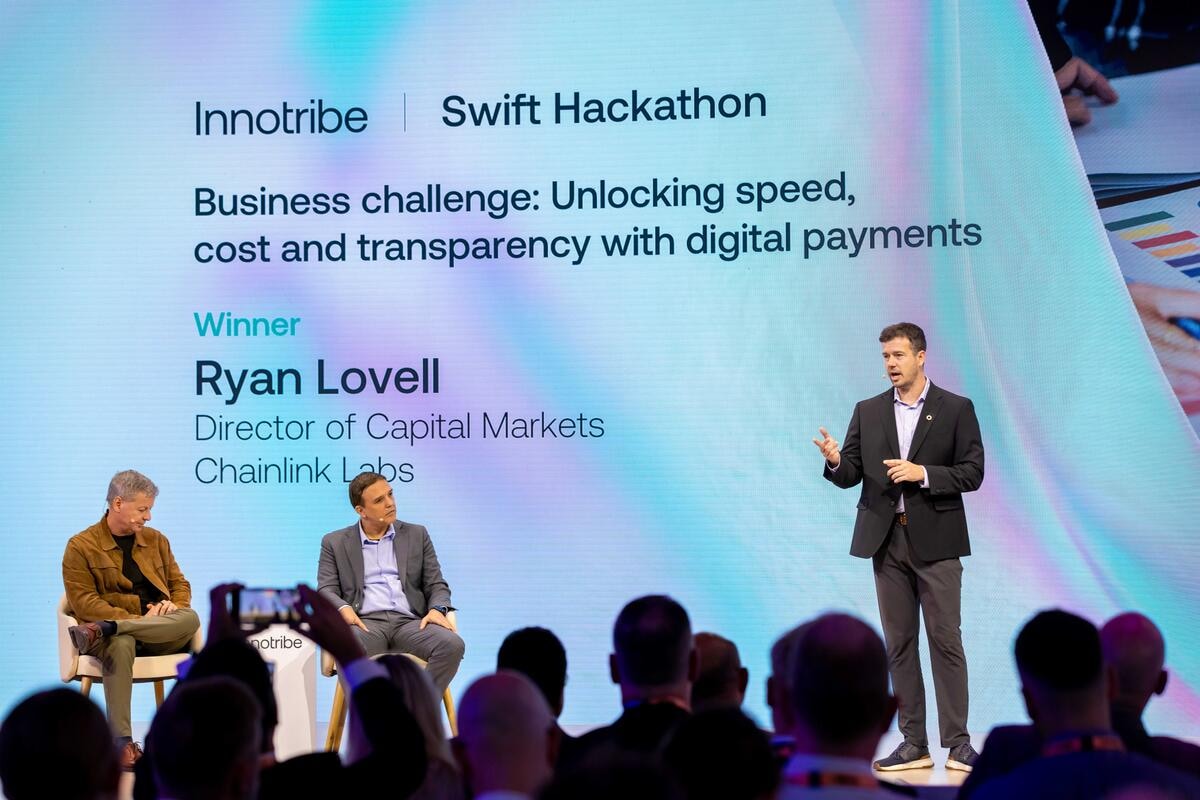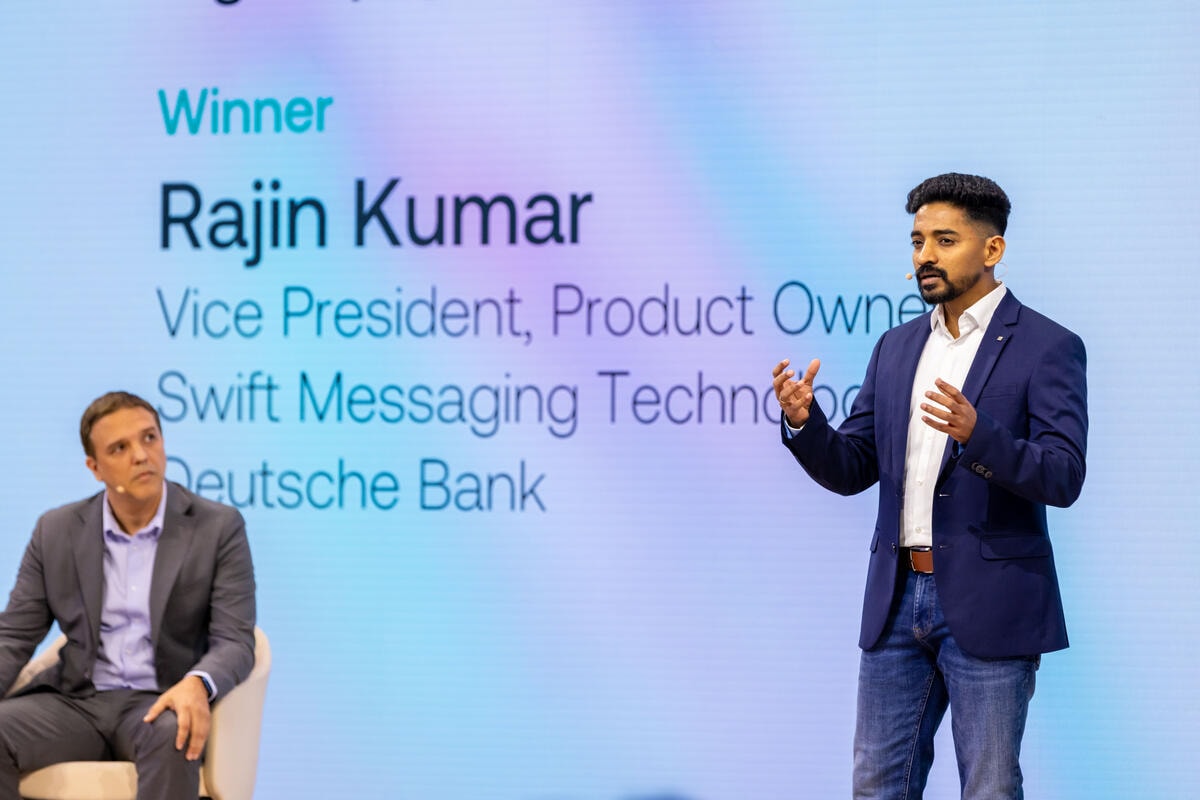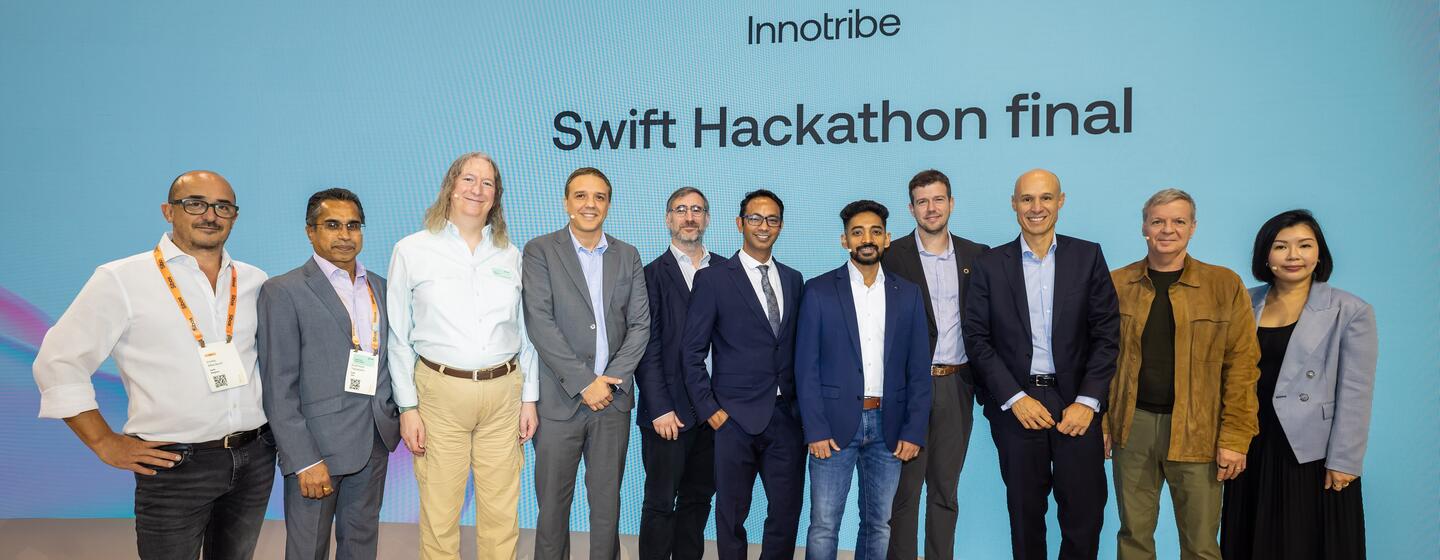This year’s Swift Hackathon saw a record-breaking number of entries, with 104 teams from around the world showcasing bold ideas to tackle two critical challenges shaping the future of payments.
We’re thrilled to name the winners of the 2025 Swift Hackathon – Chainlink, winner of the Business Challenge, and Deutsche Bank, winner of the Technical Challenge.
Hot on their heels were two outstanding runners-up: Credit Agricole CIB in the Business Challenge; and Currency Network Ltd in the Technical Challenge. We’d also like to give an honourable mention to Banco Guayaquil and Exactpro for their creative approaches and strong execution.
👏 Congratulations to all the winners and participants for delivering truly innovative solutions that push the boundaries of what’s possible in digital payments.
Streamlining global digital currency flows
This year’s Hackathon focused on a critical theme: overcoming fragmentation and improving interoperability in the digital asset ecosystem. In today’s digital asset ecosystem, fragmentation and a lack of interoperability between networks is a major concern – especially for firms adopting new forms of money. There’s also a clear need to connect these emerging networks with established systems.
Participants were invited to tackle one or both of this year’s challenges:
|
The Business Challenge |
The Technical Challenge |
We caught up with our winning teams to learn how they approached these challenges and developed their award-winning solutions.
Business Challenge winner: Chainlink
The winner of this challenge, Chainlink, had previously achieved success in Swift’s 2016 Innotribe Industry Challenge, an early forerunner to the Hackathon. “That’s how Chainlink and Swift’s relationship started – which has led to a range of cutting-edge digital asset innovations,” says Ryan Lovell, Director of Capital Markets at Chainlink Labs.
Since then, the company has taken a keen interest in Swift’s Hackathon challenges. So when this year’s theme was announced, Chainlink jumped at the chance to showcase their capabilities and explore what the future of global money and reusable digital identity should look like.
The first step was to gain a clear understanding of the challenge itself, the type of solution that would be a good fit, and the technology stack that would be needed. “Our ongoing work with partners like Global Legal Entity Identifier Foundation (GLEIF) helped us better understand how to deliver a winning solution that meets the needs of digital payments globally,” says Lovell.
Key to this exercise was understanding how to connect different pieces of technology. "Flexibility is essential when building blockchain solutions for regulated capital markets. Individual components, whether for data delivery, cross-chain messaging, or identity verification, can perform specific tasks well, but without a unifying layer they remain fragmented,” said Lovell.
“The Chainlink runtime environment solves this challenge by providing a higher level of abstraction and orchestration. This transforms these building blocks into coordinated workflows, enabling institutions to seamlessly connect on-chain and off-chain systems, streamline complex processes, and achieve outcomes greater than the sum of their parts."

Automating compliance
The resulting solution also leverages the Chainlink’s automated compliance standard, a modular and composable set of on-chain smart contracts and off-chain services built on the Chainlink runtime environment that enforce regulatory compliance requirements for financial products.
“With this solution, we’ve shown how a transaction can be initiated and validated on-chain, with identity and compliance checks enforced automatically through policy rules,” explains Lovell. “The fiat payment is then processed off-chain via Swift, which in turn triggers on-chain settlement and delivery of the digital asset – bringing traditional and digital finance together in a fully automated, secure, and compliant workflow.”
The solution, enhanced by GLEIF’s trusted identity framework vLEI, reduces user onboarding time by automating sanctions checks and KYC workflows, eliminating various costs. It empowers institutions to speed up cross-border transactions while simultaneously reducing compliance risks, safeguarding privacy, improving transparency, and ensuring auditable on-chain transaction records.
Chainlink greatly enjoyed the experience of taking part in this year’s competition. “Winning the Hackathon is a huge accomplishment,” adds Lovell. “It’s a strong validation that the Chainlink platform’s capabilities around compliance, orchestration, and interoperability empower institutions to scale digital assets globally.”
He says that the topic of this year’s Hackathon was particularly timely. “The blockchain industry has come a long way since its inception, and is now really at the production stage. That’s why interoperability, compliance, digital identity, and reporting are becoming so important. You can’t really scale unless you address those challenges.”
Technical Challenge winner: Deutsche Bank
Exchanging value between traditional currencies and digital currencies requires a complex set of interactions between different infrastructures and networks. As such, our technical challenge invited teams to develop solutions that use ISO 20022 to enhance interoperability for cross-currency, cross-network payments flows.
The challenge attracted many creative solutions – but for the judges, Deutsche Bank’s team emerged as the clear winner. In recent years, the bank has been doing a lot of work involving Swift APIs, including going live with Swift’s Instant Cash Reporting (ICR) solution and carrying out a recent proof of concept focusing on FIN, FileAct and other protocols. At the same time, the bank has been paying close attention to Swift’s recent papers on central bank digital currencies (CBDCs).
With the rise of stablecoins, CBDCs, and evolving regulations like the FATF Travel Rule and the Markets in Crypto-Assets Regulation (MiCA), transparency around counterparties and assets is more critical than ever. As a bank, we’re strongly positioned to support that – not just in traditional payment networks, but also by helping clients to connect to emerging digital ecosystems. The Hackathon gave the firm a chance to extend its earlier proof of concept and show how ISO 20022 can enable true interoperability explains Chris Bezuidenhout, CIO Cash Management at Deutsche Bank.
The bank’s Swift team kicked off the process by discussing the topic internally, with a focus on how connectivity using Swift APIs could be integrated into the current regulatory landscape.
In a traditional banking system, KYC is already tied to the primary account – but in digital currency networks, that visibility often disappears.” says Bezuidenhout. “As soon as transactions cross networks, regulatory frameworks like the Travel rule demand transparency. That’s where banks can step in – not just enriching transaction with existing KYC data, but performing real-time screening and compliance checks to ensure secure and compliant value exchange without compromising innovation.”

Seamless and transparent
The resulting solution – Deutsche Bank’s Digital/Fiat Currencies Interlink Bridge – uses ISO 20022 to enable interoperable transfers and settlements of CBDCs and digital currencies across jurisdictions, complete with compliance checks and real-time tracking.
The solution’s architecture enriches ISO 20022 messaging with new data fields for blockchain-native identifiers, wallet addresses, transaction hashes, and token IDs, thereby supporting both traditional and digital asset flows. The prototype also demonstrates automated KYC, LEI verification, FX conversion and blockchain validation workflows.
As Andrey Ovchinnikov, Deutsche Bank’s CIO of Client Connectivity explains, “the whole idea was to keep it integrated into the current banking ecosystem, and make it as seamless and transparent for the bank’s customers.”
Greater insights
For the bank, the experience of taking part in the Hackathon was both challenging and educational. Along the way, the bank’s Hackathon team gained greater insights into the topic of digital payment settlements and compliance around it by joining forces with experts within the bank.
The unique experience here was trying to solve such a real-world challenge on interoperability around digital payments and experimenting with the technology on LEI verifications, enhancing the ISO 20022 formats with blockchain identifiers, while focusing on integrating the solution into an existing banking ecosystem,” says Bezuidenhout.
Reflecting on the bank’s success, Ovchinnikov concludes: “The whole team was excited to win the Hackathon, and have the opportunity to showcase our solution to the Swift community. It’s a great achievement, and everyone who worked on the project can be proud of what we have done.”
Looking ahead
The 2025 Swift Hackathon highlighted the immediate need to connect emerging digital money networks with established infrastructures. From compliance automation to cross-currency settlement, this year’s winners demonstrated how innovation can deliver more secure, efficient and interoperable payments worldwide.
Got ideas?
We want to hear them. Get in touch and let’s make them a reality.




